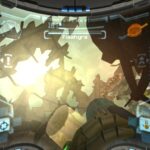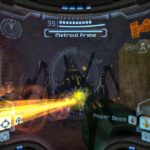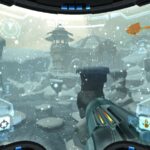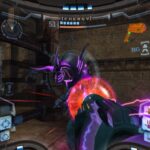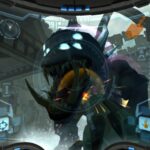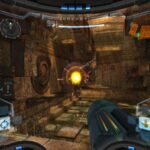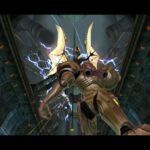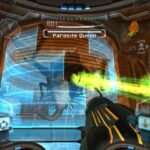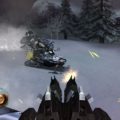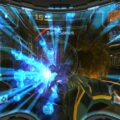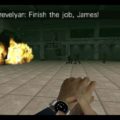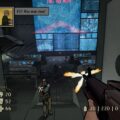Developer: Retro Studios Publisher: Nintendo Release: 11/18/2002 Genre: Action
Metroid Prime should not have worked. As Nintendo brought all of their intellectual properties into the third dimension on the N64 Metroid was conspicuously absent. When it reemerged on the demo reel for the GameCube many were excited. But the announcement that it was first person was questionable. Add to that the turmoil going on at Retro Studios and the outlook was pretty grim. Although some titles like Turok featured platforming it was tolerable at best. How would a series with some of the heaviest precision platforming fare in the first person? Apparently not that well going by its E3 2002 demo. By all accounts Metroid Prime was going to be a disaster.
Call it a miracle if you like but a strange thing happened. Between its E3 debut and November release Metroid Prime would come together in a way that is rare in this industry. But it should come as no surprise; all of the pieces were there Retro simply did not have time to assemble them in time for the show. Metroid Prime is one of the highest rated games of all time for a reason. Not only did it establish Retro Studios as one of Nintendo’s best studios it is also one of the greatest adventure games of all time.
The Metroid Prime series takes place between the original and Metroid 2. Samus intercepts a distress signal from a space pirate frigate under attack. The frigate is destroyed by Ridley and crashes on the nearby planet Tallon IV. Samus follows it and slowly uncovers mystery of this strange planet and the pirates plans for mysterious substance known as Phazon that covers the planet. Despite being an interquel between the initial two games Metroid Prime almost feels like the first in the series because of the amount of backstory it gives to the Metroid universe. This is one of the reasons I like it so much.
Compared to most games in the series Metroid Prime is story heavy. However how much you delve in to the plot is in your hands. Using the scan visor you can scan a significant number of objects in the environment. From the general flora and fauna to the creatures you encounter the game is rife with information if so desire it. These are not just fluff; scanning enemies will reveal weaknesses too. The space pirate logs will reveal intimate details about their plans and operations on Tallon IV and their progress. Many of these logs also reveal their thoughts on Samus as well. The most important are the Chozo lore carvings that disclose more information about the history of the Metroid universe and Samus herself. So for those that like the silent storytelling and isolation inherit to the series it is there; if you want lore you can feast.
Despite the shift to first person this is not a Doom clone. Adventure is still the prime (heh) focus with combat being a means to an end. You will not enter a room and face hordes of enemies waiting to be mowed down. The game does borrow from most popular fps games by allowing you to circle strafe enemies and quick dodge. You can still freely aim and look around if need be but it is not necessary. The generous lock-on targeting is more than adequate to take out most enemies. It is not until the space pirates in all of their various configurations appear that combat becomes more complex. These foes are smarter and will actively hide behind cover, dodge your attacks, and are aggressive. It is a nice change of pace and shows that even platforming and such is the focus combat is still important.
Where Metroid Prime succeeds when other first person platformers fail is its controls and use of its viewpoint. When you jump the camera shifts slightly to show you where you will land. It is a simple solution and one that works beautifully. I can honestly say that 90% of the time I missed a jump it was my fault. The only time the game shifts to third person is in morph ball mode which is a smart choice. As you gain new upgrades they can switch using the D-pad and C-Stick. Outside of accessing the map and reading the various lore you have uncovered you never have to pause to access your inventory.
There are a variety of familiar suit upgrades as well as brilliant new additions. The various beam weapons return but do not stack. Since you can switch in real time with the C-stick the game presents numerous situations that take advantage of this. The morph ball sees extra utility with the boost ball and spider ball that increase your means of traversing environments. The greatest additions however are the various visors. Apart from the scan visor Samus will gain the X-ray and thermal visors. Aside from looking cool their integration is borderline genius. The x-ray visor can see through walls and reveal invisible objects. The thermal visor enables navigation through darkness and tracks heat sources. Both of these additions are extremely cool with the game making fool use of these tools. Completionists will have to use them extensively to find every secret to unlock the hidden ending.
The world of Tallon IV is a master class of level design. As you explore the planet there are tantalizing glimpses of areas that are inaccessible everywhere. There is a logical progression to how you gain your suit upgrades and the new options and shortcuts they unlock. Even though the game calls on you to travel back and forth, sometimes a great distance, the many elevators that become accessible make it a breeze. You receive some guidance as the game will mark a key location you should explore on the map. How you get there and whether you actually want to is in your hands. You can also turn this off if you like.
Since the game is in 3d environmental puzzles play a greater role in making exploration fun. Once you learn that the X-Ray visor can show hidden platforms it will make you look at previously impenetrable rooms in a new light. The way they hide missile and energy tanks is downright incredible and on the level of Super Metroid. Doors are color coded to your weapons which makes retracing your steps to visit previous areas easier. I like how much emphasis is put on the morph ball as well as the extensive segments that call on the spider and boost ball. Somehow they have struck the perfect balance of providing a helping hand but at the same time making you feel as though you figured it out on your own. I could go on and on but I think I have made my point.
The art direction of Metroid Prime is absolutely stellar, making it one of the best looking titles from that generation both artistically and technically. The work done by Retro Studios is monumental. Every single room is individually crafted with no recycled textures. Considering how large the game is that is insane. Every individual crack, bump, and divot were fully modeled to add to the realism. Each of Tallon IV’s areas is incredibly distinct. The Chozo Ruins remain mostly pure with wild plant overgrowth despite their closeness to the source of Phazon. The Phazon Mines is where the space pirates conduct most of their research and is fortified like a military installation. The first time you step in to Phendrana Drifts is a moment and the game savors it. The various visor effects are the cherry on top next to the near flawless 60 fps.
Of course the presentation is not perfect. You can see areas where they sacrificed to realize their vision. Low polygon objects in the environment stand out and some textures do not stand up on close scrutiny. But that is only because the presentation in general is so amazing. Although it appears to have no load times they are there in the background, the game cleverly masks it. Occasionally a door will refuse to open or won’t let you pass for a seconds as it loads the next area. If that is the price we pay for such a stellar production then so be it.
The soundtrack by series composer Kenji Yamamoto is just as moody as Super Metroid and I would say even more diverse. The range of instruments is greater with guitar hooks, piano, and other synthesized instruments contributing to the oppressive mood. The sound is also dynamic; when you enter a room you’ll instantly know if there are space pirates present as the music becomes frantic and you’ll hear their guttural howls. Add in a large number of environmental sounds and you have an audio package that is almost as good as the graphics.
In Closing
I’ve given Metroid Prime an endless amount of praise because it deserves it. The sheer number of game of the year awards the game has speaks to its quality. Metroid Prime is one of the greatest games of all time and one of the best in the GameCube library. One word sums it up: classic.


